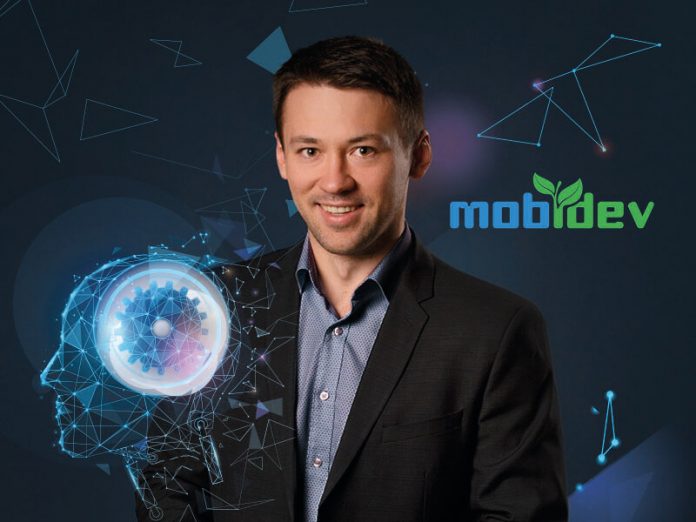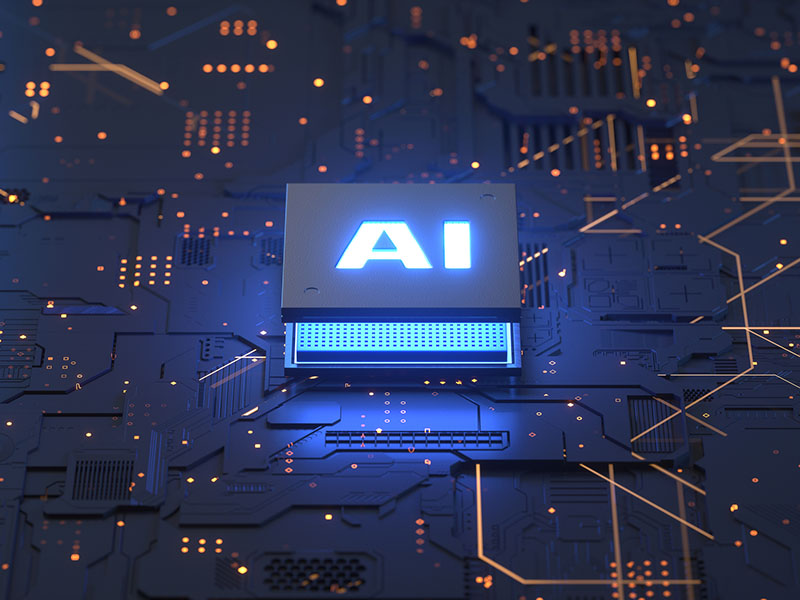How can businesses leverage artificial intelligence effectively? Oleg Lola, CEO of MobiDev, outlines his company’s approach to harnessing the power of AI in the design of effective solutions for companies across a range of sectors, and in particular the central role played by the customer in the design process.
For many people outside the IT sector, the expression “artificial intelligence” is something of a mystery. Could you tell us what you understand by this term?
There is a lot of history behind the term “artificial intelligence”, and it’s not new at all. This term started showing up in the 50s and 60s, and a lot of fictional literature is dedicated to it. But why is it popular right now? I think there is one main reason. In 2012, a new approach appeared in computer science. When I say a new approach, I mean AlexNet, which is the first convolutional neural network.
AlexNet was able to find patterns in images. It became possible because Nvidia created a technology called CUDA, and basically, it allows us to process significant volumes of primitive data simultaneously. So it’s pretty fast, which is required in order to train a neural network. Engineers began to use AlexNet and create other similar architectures for the fast training of neural networks. There was emplaced hardware technology combined with some scientific ideas on how a neural network could be trained. It resulted in a revival of artificial intelligence.
Why do we call it “artificial intelligence” when this can be considered a conditional term? It’s because the human doesn’t describe the task. People cannot explain how they classify, for example, a car in a picture. In the case of artificial intelligence, the situation is almost similar. But AI is not a mystery or magic. It requires input. In fact, a neural network analyses low-level and high-level features in a picture, and we need data to train it. And nowadays its accuracy is even higher than a human’s.
In very simple terms, what are the components of an AI system? Can such a system be assembled today from “off the shelf” components, or is it necessary to do bespoke development in each case?
Artificial intelligence is a branch of computer science that is concerned with the development of smart machines capable of performing tasks that typically require human intelligence. There are several levels of ready-to-use solutions that can help to perform such tasks. Perhaps you already know about pre-built tools and apps like IBM Watson.
Viewing the components of an AI system, we can draw an analogy with websites that differ in their complexity. In AI, there are five levels of complexity:
- Amazon AutoML.
- Semi-automatic tools like Azure AI and Amazon SageMaker can be used if you understand how machine learning works.
- Third-party libraries like Google Cloud Vision (OCR) or Google Speech-to-Text.
- Ready-to-use models like VGG, BodyPix, Keypoint R-CNN, StyleGAN. They can pass the additional training on your data to improve recognition accuracy with the maintenance of basic layers that perceive primitives.
- Custom models developed from scratch. To get the result in this case, we need a massive amount of data (millions of samples). Custom AI models are highly valued for addressing unique business challenges.
In general, what do you see as the benefits of an AI-powered system, as compared to a non-AI one?
AI offers solutions to tasks that couldn’t have been solved before or to tasks where the solution was complicated. It helps to simplify the process. You can take advantage of AI by analysing data and automating decision-making for the business. So, in general, AI-powered systems are more capable.
AI-powered systems are in high demand. You should consider their application for business if you have an ample amount of data, video, images or text. It is relevant to most industries. Demand is rising because of the emergence of new AI-solutions like GPT-3.
Your company’s portfolio of delivered AI-powered solutions is impressive. How much overlap might there be between AI systems that are employed in different business contexts?
The answer to this question is like a double-edged sword.
On the one hand, AI-powered solutions can resonate with each other, especially when we speak about the same niche. Let’s look at an example. There is a social business that encourages the use of social transport. The user takes a photo while riding the bus. After that, an AI-powered system determines whether the photo was, indeed, taken on the bus. One part of the process is object recognition that can be successfully used in other areas.
On the other hand, AI-powered solutions for computer vision, NLP, speech and optical recognition, or predictive modelling can be totally different and be built from scratch. Therefore, everything depends on the client’s business.
What is the AI apps concept, and how could it bring value to business leaders?
AI apps bring value to business leaders if they know roughly what they want to achieve. This is possible to assess after business analysis. When your aims are clear, it’s possible to achieve them. For example, AI solutions are useful if your goal is to predict sales or find out which employees are efficient. Here we have at least approximate vision, so we can build a model, evaluate it and deploy it. An inherent attribute of this process is a significant amount of data. As usual, at the first stage, we consider business values and metrics provided by the client or prepare them with the customer’s help.
Sometimes, business leaders want AI magic without any clear vision. In this case, we help them analyse which data we can receive, where to move, and what benefits the business can gain due to AI solutions implementation. For example, let’s look at our case with the automotive industry. We found out that AI tools could bring value and serve for sales forecasts to benefit our client. Our team used sentiment analysis (interpretation and classification of emotions within text data) and image classification (CV). These tools have proven to be effective when we need to find out an attitude to a particular brand, in analysing responses, gathering information from social media, and other tasks.
Describing the value that AI can bring to all businesses is impossible. We need to choose a particular company and analyse it.
Your company places great emphasis on client-centred, personalised services. Can you enlarge on what this means in practice? Can you describe your customers’ involvement in the process of developing services for them?
When a client comes to MobiDev, their first goal is to receive the solution. But all the clients perceive the service differently. Our company, as a service provider, tries to involve the customer in the process without overburdening them. Under this approach, clients enjoy the interaction with the team.
The level of client involvement in the development process depends on their needs, preferences and requirements. A high level of involvement is desirable if the customer’s niche is innovative. Also, it is mandatory if there are a lot of permanent changes to be made, or when business leaders are still defining the product they want to receive. With such clients, we agree to milestones or sprints in which they take part. Also, we plan a convenient schedule for meetings.
No matter how often clients want to communicate with us, we understand that the main task for them is their business. While they focus on it, MobiDev’s team does the necessary routine work, offering transparency and an easy way to make decisions.
The world of digital technology is fast-changing. How do you approach R&D? Do you wait to be approached by a potential customer, or do you proactively research promising technologies in order to seek customers later?
We use the term “research” in our company. It refers to mastering new technologies which our company didn’t widely use. Part of these technologies are convenient for clients and help to solve tasks. We could get them up and running.
If we speak about MobiDev’s experience with R&D, this is about 30% of our workload. We pay enough attention to research because it is fundamental for intensively developing tech like artificial intelligence.
The team is a core for any service business. And it’s even more important in terms of engineering expertise and the ability to deliver technological products. What’s your approach to building and evolving the team?
For us, the team is something coherent and, first of all, it includes the customer. The client is as valuable as engineers for our success. We build beneficial relationships with employees and clients based on a win-win approach – MobiDev benefits from its purposefully light atmosphere, transparency and understanding of our path. Also, to us the team is made up of people that work on the same task and cooperate, so we pay serious attention to communication.
We are interested in the growth of all MobiDev’s employees, and our approach to building and evolving the team has been adapted to the pandemic. But we insist on cooperative work in which the client can be involved.
 What are your clients’ typical reactions when you describe the approach to developing an AI solution? Might they have concerns because they perceive the technology to be immature or the process unclear?
What are your clients’ typical reactions when you describe the approach to developing an AI solution? Might they have concerns because they perceive the technology to be immature or the process unclear?
We try to explain our approaches clearly, in the most straightforward way. Our presentation should be understood even by clients who do not have any technical background. This allows customers to feel more comfortable, because the process is quite clear. In general, we explain illustratively with appropriate examples, speaking frankly about risks, but trying to convey the idea that they are manageable.
We break the whole process down into small iterations named “proofs of concept”. Sometimes the number of proofs of concept reaches five or even more. We can manage risks and are ready to develop the needed AI solutions that allow the business to feel comfortable due to such an approach.
What issues might a company need to take into account when considering implementing an AI-powered system?
First of all, a company must be ready to do the research and create solutions from scratch. Business leaders should know their problems, have data or be ready to collect it, and must be aware of how to measure success. Simultaneously, AI-powered systems require ongoing support in the future, and this should also be taken into account.
Are there any business sectors where you see as-yet unfulfilled potential for the application of AI in the future?
Nowadays, leaders in the adoption of AI invest more in the near future. AI solutions are in high demand in different areas: high tech and communications, financial services, energy and resources, transportation and logistics, automotive and assembly, etc. At the same time, there are sectors where AIs potential is still unfulfilled, but that’s going to change soon. Among such industries are travel and tourism, professional services, buildings materials and construction, etc. Also, we will see a rise in the costs related to the implementation of AI solutions in healthcare, retail and education.
Are AI-powered solutions within the reach of only large companies with correspondingly large budgets, or is there something there for small and medium-sized businesses too?
No, AI-powered solutions aren’t only for a big budget. We work with companies of different sizes, some of which are startups with small funding. It means that, indeed, a big budget isn’t a must in order to reap the benefits of AI. The optimal solution is chosen according to the clients’ capabilities. It can be ready-to-use or built from scratch.
How do you see the impact of AI on business decision-making in general in the future? Where will AI be evolving in a couple of years?
There are three levels of decision making in AI: descriptive, predictive and prescriptive. The descriptive approach explains what is happening in the system right now. The predictive approach is a second level; it describes what could happen, helps to semi-automate decision-making, and draws attention to specific points. The prescriptive approach is fully automatised; it gives a ready-to-use decision provided by the machine.
Typically, only the two first levels are being used. The typical example is the system of evaluation of credit issuing. When a person comes to a bank wishing to take out a loan, the credit history and other vital data are analysed. Microcredits within the evaluation of these parameters are already automated. This is implemented through the prescriptive approach by finding out whether the borrower will repay the loan. When we speak about a vast amount in the same case, it should be mentioned that the prescriptive approach doesn’t work. This is because of the significant risk. But more and more crucial decisions will be made with the help of AI in 5-10 years. So, let’s get ready for this tech evolution!
Executive Profile
Oleg Lola now puts plenty of his efforts to drive AI technology services to MobiDev clients. As the company provides complex software technology services (web and mobile, cloud, etc), Oleg is focused on forming an “AI apps concept”. For example, among many initiatives, we now provide every client with the consultancy about the extra value could be gained implementing AI to his or her product.







































